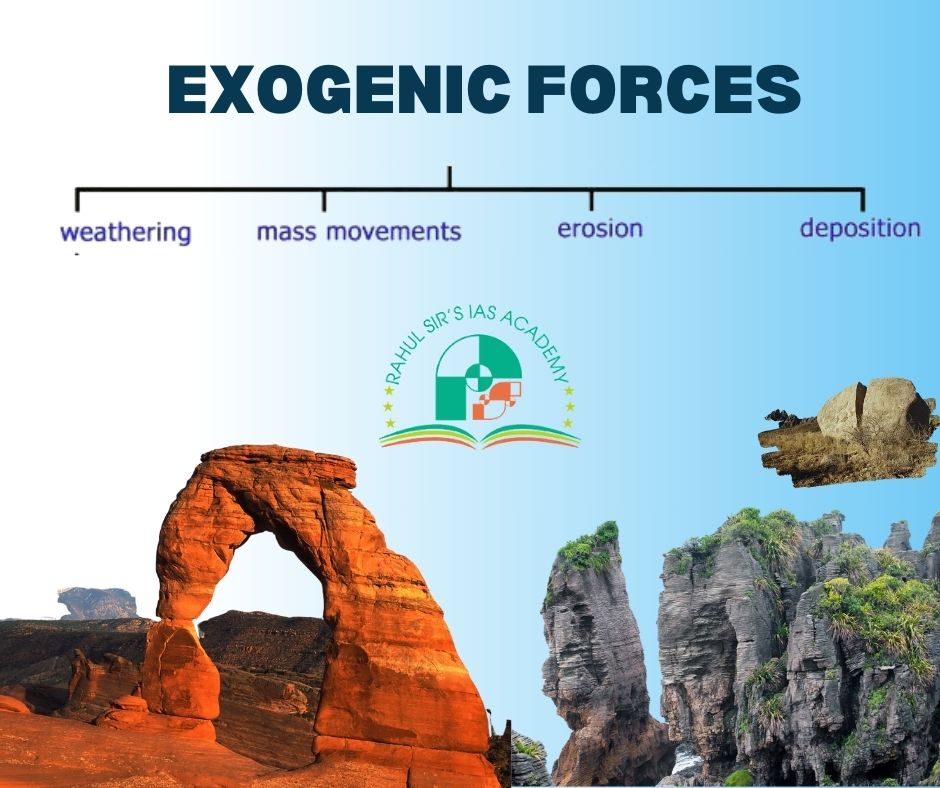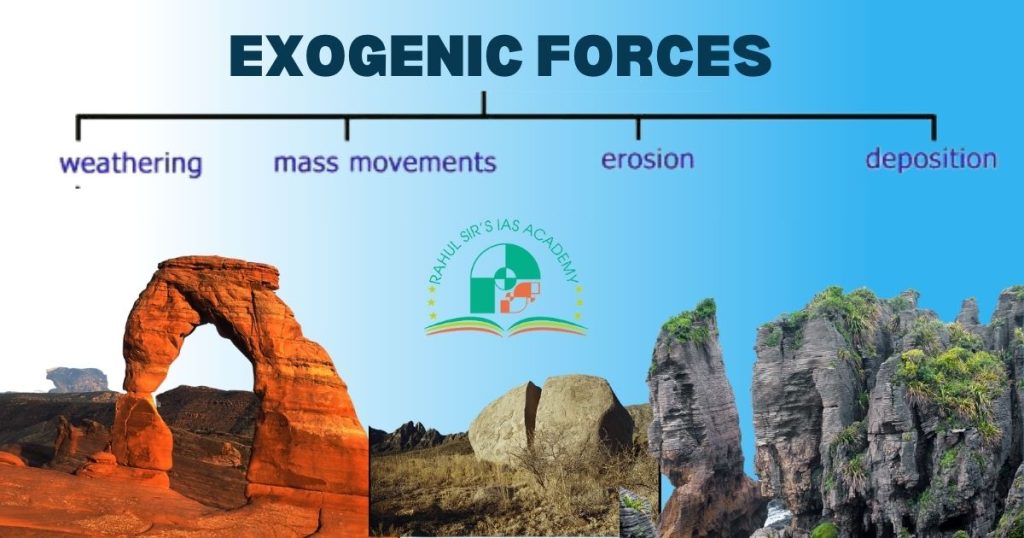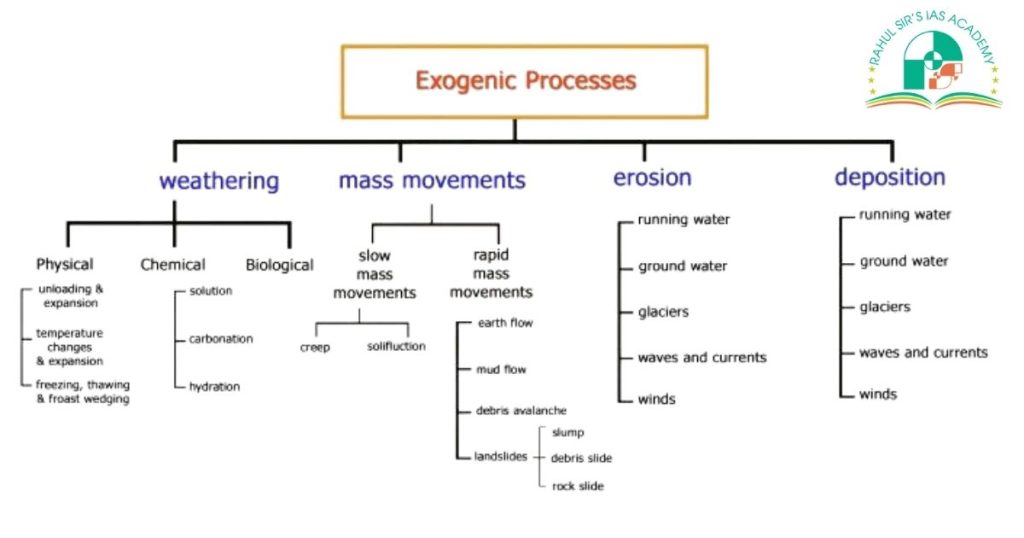
Exogenic Forces – Weathering, Erosion And Mass Wasting
What are Exogenic Forces?

The exogenic forces are the forces that originate outside the earth’s crust, mainly from the atmosphere, and are also termed as exogenic processes. These processes are continuously engaged in the destruction of the relief features created by the endogenic forces. Since they can cause existing land forms to be destroyed by weathering and erosional processes, these forces are often called “destructive forces”. The major exogenic forces include Weathering, Mass wasting, Erosion and Deposition. These forces are a part of the overall geomorphic forces that are responsible for the creation and destruction of relief features on earth. The other type of forces are known as Endogenic Forces. The concept can become more clear with the following diagram :
Exogenic Forces
A clear picture of all the exogenic forces can be seen from the following diagram. Throughout this article we shall delineate all the salient aspects of the Exogenic Forces.

WEATHERING (Exogenic Forces)
First component of exogenic forces is Weathering. It is a process of disintegration and decomposition of rocks in situ i.e. at their places involving no transportation due to mechanical and chemical processes is called weathering. Water, ice, acids, salts, plants, animals, and changes in temperature all contribute to weathering. The work of weathering can be grouped into two broad categories – Physical Weathering and Chemical Weathering. Biological weathering, which is due to living organisms i.e. plants and burrowing animals also contribute to weathering. Biological weathering can be a part of both processes.
Physical or Mechanical Weathering
When rock is broken and disintegrated without any chemical alteration, it is called physical weathering . It can take place in several ways.
a. Thermal Expansion and Contraction: In dry clouds region (hot and cold desert), intense heating during day time causes expansion of rock parties while rapid cooling during night leads to contraction. The repetition of this process results either in Block disintegration along the joints of rocks or granular disintegration of the coarse-grained, multi-colored rocks. This process is termed as thermal stress. Thermal stress weathering is an important mechanism in deserts, where their diurnal temperature range is very large, hot in the day and cold at night.
b. Exfoliation: Exfoliation refers to peeling off concentric shells of rocks due to combined action of thermal changes and winds in hot and semi-arid regions. It is more common over crystalline rocks. Exfoliation can also be caused by the removal of superincumbent load and consequent release of confining pressure. Exfoliation contributes to the formation of Bornhardts. They are tall, domed, isolated rocks often found in tropical areas e.g Sugarloaf Mountain, in Rio de Janeiro, Brazil.
c. Frost Action: In cold climatic regions, when water is present in pores, crack etc. freezes , it expands exerting a bursting pressure and breaking the rocks into fragments. When water freezes, its volume increases by 9.2%. This freeze-thaw cycle is called frost weathering or cryo fracturing.
d. Biotic Action: Roots of the plants penetrate the rocks below, usually along joints and other lines of weaknesses, ripping them apart. The burrowing animals, worms and other organisms also help in gradual breakdown of rocks.
e. Pressure: Changes in pressure can also contribute to exfoliation due to weathering. When the rock surface expands, it becomes vulnerable to fracturing in a process called sheeting.
f. Haloclasty: This happens due to the action of salt. Saltwater sometimes gets into the cracks and pores of rock. When the saltwater evaporates, salt crystals are left behind. As the crystals grow, they put pressure on the rock, slowly breaking it apart. Due to this hundreds or even thousands of pits formed by the growth of salt crystals resulting in Honeycomb weathering. Honeycomb weathering is common in coastal areas, where rocks constantly interact with seawater salts.
Chemical Weathering
In chemical weathering, rocks decompose and disintegrate due to chemical reactions. The main chemical weathering processes are :
a. Dissolution: Refers to the dissolution of the soluble particles and minerals from the rocks by the action of water. In this a mineral dissolves completely without producing any new solid substance. Solution is more significant in case of calcareous rocks and thus helps in the production of Karst landforms.
b. Oxidation: In it oxygen dis-solved in water reacts with certain rock minerals , especially those containing iron to form oxides. This gives the affected rocks a reddish-brown coloration on the surface which crumbles easily and weakens the rock.
c. Hydration : It involves absorption of water by the rock minerals, causing it to expand and thereby initiating stress within the rock. In this the chemical bonds of the mineral are changed as it interacts with water.
d. Hydrolysis : It involves active participation of water in chemical reactions to produce different minerals. In this a new solution is formed as chemicals in rock interact with water. In many rocks, for example, sodium minerals interact with water to form a saltwater solution.
e. Carbonation: Carbonic acid made by the combination of water and carbon dioxide dissolves many elements of minerals. It is more prominent in the Limestone regions (Karst topography).
Effects of climate on weathering
- Physical weathering is more important in hot and dry climatic regions because of the high diurnal range of temperature found here.
- Intense chemical weathering in hot and humid regions.
- Chemical weathering is minimal in desert and Polar Regions.
- The rocks in dry temperate climates are more susceptible to mechanical weathering due to frost action.
- Weathering is at its minimum in the Polar Regions due to permanent ice-cover.
- Both physical and chemical weathering are prevalent in the monsoonal regions (India)
- Carbonate rocks having more soluble minerals are easily affected by chemical weathering.
- Climate is thus, the single most important factor influencing weathering.
EROSION (Exogenic Forces)
Second component of exogenic forces is Erosion. It refers to those processes of denudation which wear away the land surface by mechanical action of the debris which is being transported by the various agents of erosion (glaciers, winds, rivers, marine, waves & currents). It is Distinguished from the weathering in which no transportation is involved. Thus erosion is not a synonym of denudation, rather a part of it.
Note : Denudation is the sum total of the processes which result in the general leveling of the land surface. It includes a gradation signifying filling up of low lands and depression with sediments and degradation comprising erosion , mass movement , weathering etc.
Each of the agents of erosion does their work by distinctive processes giving rise to distinctive landforms. Running water is the most important agent of erosion. The main process involved in the erosional activities are :
- The acquisition of weathered material.
- Wearing away from the surface through impact of rock materials in transit and in some cases by solution.
- The breaking down of rock particles by mutual wear and tear.
- Transportation of the acquired rock debris by moving medium.
Concept of Base Level
Put forward by J.W. Powell in 1875 , the base level concept denotes the lowest level to which the stream can erode. The base level, in fact, is the elevation of the stream’s mouth, where the stream enters an ocean, a lake or another stream. In hydrology and geomorphology, the term base level is the limit below which flow of water cannot erode. Alternatively, the stream of water cannot cut deeper than its base level; therefore, its energy goes into cutting its banks sideways. As a result, the stream meanders, gradually widening its valley. Finally, the sea-level is the ultimate base-level. A rise in sea level weakens the erosive capacity of streams and a fall in base level strengthens it, giving rise to rejuvenated topography.
Cycle of base level
The cycle of erosion is an acclaimed concept given by W.M. Davis envisages that the evolution of physical landscape follows an orderly & cyclic sequence. According to it an uplifted landmass undergoes its transformation by the agent of denudation and passes through the stages of youth, maturity and old, ending into a low featureless plain, termed as Peneplain.
Mass Wasting (Exogenic Forces)
The third component of exogenic forces is Mass Wasting. It is a process of erosion due to gravity and the mass transported down the slope is without the medium of wind, water or ice. Apart from gravity the other 2 important factors that contribute to mass wasting are water (acts as a lubricant) and the triggering mechanism (seismic activity). It is found everywhere but tends to be most effective in mountainous areas where the gradient is significant, and plays a considerable role in the Geomorphic evolution of a landscape. Mass wasting process, can present a significant hazard in the form of landslides, slope failures, and avalanches depending upon the level of forestation and slope gradient. Four types of mass wasting are slump, rockslides, debris flow, and earthflow.
Conclusion
In conclusion, the study of exogenic forces in the field of geology is of paramount importance in understanding the dynamic and ever-changing nature of our planet’s surface. These external processes, including weathering, erosion, and deposition, play a fundamental role in shaping the Earth’s landforms, from towering mountains to meandering rivers and picturesque coastlines. By examining the mechanisms and impacts of these forces, scientists and researchers gain valuable insights into the evolution of our planet over geological time scales.
Furthermore, the significance of exogenic forces extends beyond purely academic interest. It has practical implications for a wide range of societal and environmental issues. The knowledge of these processes is crucial for assessing natural hazards such as landslides, soil erosion, and coastal erosion, which can have devastating consequences for human populations and infrastructure. Understanding the interactions between exogenic forces and human activities, such as deforestation and urban development, is essential for sustainable land use planning and environmental conservation efforts.
As we continue to grapple with environmental challenges and seek to mitigate their impacts, a comprehensive understanding of exogenic forces becomes increasingly vital. With ongoing research and technological advancements, we can enhance our ability to predict and respond to natural disasters, protect vulnerable ecosystems, and manage our planet’s resources more sustainably.
In summary, exogenic forces are dynamic and influential agents of change on Earth’s surface, shaping landscapes, impacting ecosystems, and posing both challenges and opportunities for human societies. Through continued scientific inquiry and responsible stewardship of our natural environment, we can harness the power of exogenic forces for the betterment of our planet and its inhabitants.
See Also
Endogenic Forces – Folding, Faulting, Earthquakes And Volcanism
Rock Cycle – Diagram and Explanation
Interior Structure Of The Earth
FAQs On Exogenic Forces
The exogenic forces are the forces that originate outside the earth’s crust, mainly from the atmosphere, and are also termed as exogenic processes. These processes are continuously engaged in the destruction of the relief features created by the endogenic forces.

